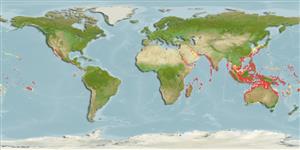Bryopsidophyceae |
Bryopsidales |
Caulerpaceae
Environment: milieu / climate zone / ระดับความลึก / distribution range
นิเวศวิทยา
; ระดับความลึก 1 - 59 m (อ้างอิง 102151). Tropical
Indian Ocean: from Saudi Arabia to South Africa, including the Red Sea and Madagascar, east to Pakistan and south to Dampier, Western Australia, including Maldives; Pacific Ocean: from Japan to the South China Sea, south to Queensland, Australia, including Federated States of Micronesia, Marshall, and Solomon Islands, east to the Hawaiian Islands.
Length at first maturity / ขนาด / Weight / Age
วัยเจริญพันธุ์: Lm ? range ? - ? cm
Thallus consists of a horizontal branched stolon and erect branches, the latter densely covered by many short ramuli; along almost the entire length of their axes. Each ramulus consisting of a short stalk and a globose tip, 1 to 3 mm in diameter; the distinct constriction between the tip of the stalk and the base of the globose tip is a characteristic of this species. Erect branches up to 15 cm in height (Ref. 80758).
Highly favoured for human consumption due to its soft and succulent texture; has a high mineral content (Ca, K, Mg, Na, Cu, Fe, Zn); also used as medicine: antifungal, lowers blood pressure (Ref. 80758). Commonly inhabits shallow, sandy to muddy lagoon and reef flats which are not exposed during low tides and where the water is generally calm. It may form an extensive bed in exceptionally good habitats. Commercially farmed in ponds and lagoons and is the most popular edible species of Caulerpa (Ref. 80758).
Life cycle and mating behavior
วัยเจริญพันธุ์ | การสืบพันธุ์ | การวางไข่ | Eggs | ความดกของไข่ | Larvae
Guiry, M.D. and G.M. Guiry 2009 AlgaeBase. World-wide electronic publication, National University of Ireland, Galway. http://www.algaebase.org; searched on 14 April 2009. (อ้างอิง 80701)
IUCN Red List Status
(อ้างอิง 130435: Version 2025-1)
CITES status (อ้างอิง 108899)
Not Evaluated
CMS (อ้างอิง 116361)
Not Evaluated
Threat to humans
Human uses
การประมง: เน้นการพาณิชย์; การเพาะเลี้ยงสัตว์น้ำ: การค้า
| FishSource |
เครื่องมือ
ข้อมูลเพิ่มเติม
นิเวศวิทยาเขตร้อนFood items (preys)
องค์ประอบของอาหาร
การบริโภคอาหาร
ผู้ล่า
Population dynamicsการเจริญเติบโตMax. ages / sizesLength-weight rel.Length-length rel.Length-frequenciesMass conversionอุดมสมบรูณ์ Life cycleการสืบพันธุ์
วัยเจริญพันธุ์
ความดกของไข่
การวางไข่
Eggs
Egg development
Larvae
Human RelatedStamps, coins, misc.
แหล่งที่มาจากอินเตอร์เน็ต
Estimates based on models
Preferred temperature
(Ref.
115969): 24 - 29, mean 27.9 (based on 1380 cells).
